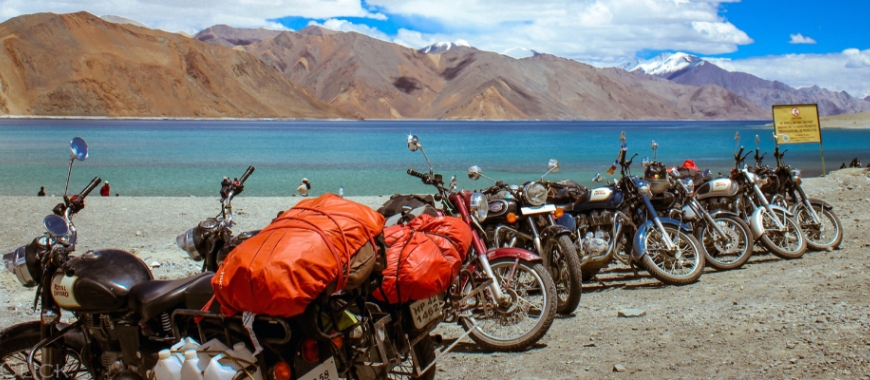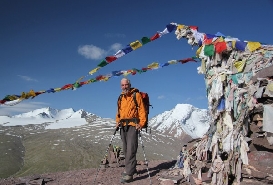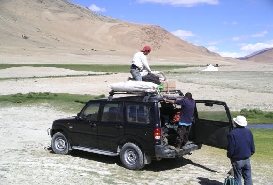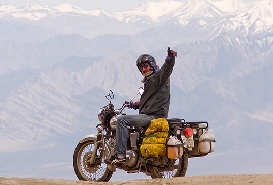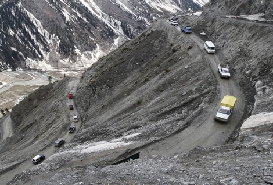Acclimatization in Leh Ladakh

Please wait...
Nestled amid the daunting Himalayas and Karakoram mountain ranges, Ladakh is known for offering some spellbinding views of nature’s beauty. However, traversing through such high-altitude areas sometimes becomes difficult, and visitors suffer from mountain sickness, which lessens the chance of enjoying your Ladakh trip. Moreover, while some visitors can handle themselves in a high-altitude environment, others cannot. Therefore, it is essential to follow a proper acclimatization procedure in Leh Ladakh.
Check out Leh Ladakh tour packages, Kargil tour packages, Yurutse tour packages
What is Acclimatization?
Acclimatization is the process of getting an individual adjusted to a changing environment, such as a change in altitude, temperature, humidity, etc. This prepares someone to maintain body fitness and perform across various environmental conditions.
Getting accustomed to high altitude is one of the most significant concerns when traveling to Ladakh. As most of the destinations and attractions of Ladakh, including Leh which is positioned at the high altitudes above 10,000 feet, visitors are exposed to a sudden change in Ladakh oxygen level. This causes them to suffer high altitude sickness, which has symptoms like headaches, dizziness, vomiting, etc. This may further lead to Acute Mountain Sickness or AMS. So, a little planning for Acclimatization to the high-altitude environment of Ladakh is surely one of the most important things to do during your Ladakh tour.
Causes of Altitude sickness
The main reason for altitude sickness is sudden arrival at a higher place. If you stop at places at a specific height and rest before going very high, you can avoid the mountain sickness. Otherwise, the condition may get worse. Most visitors can easily go up to 8000 feet, but the problem starts above this level. Here are the scales of Altitude:
- 8,000 – 12,000 feet (High)
- 12,000 – 18,000 feet (Very High)
- 18,000 feet and above (Extremely High)
Once you reach a very high level, the breathing rate becomes higher as the intake of Oxygen becomes less, which causes breathlessness. However, if you spend enough time at the preceding high altitude level, the body gets accustomed to the available Oxygen level, known as Acclimatization. So, before planning a trip to Ladakh, you must make yourself aware of Ladakh altitude levels and related illnesses and how you can take care of yourself.
Check out Lamayuru tour packages, Delhi to Leh Ladakh trip, Lamayuru Alchi trek tour package
Acute Mountain Sickness and its symptoms
Mountain Sickness sometimes becomes severe as you move to a higher elevation of Ladakh. This is called Acute Mountain Sickness (AMS), which is generally experienced above 10,000 feet. The condition can worsen when one sleeps since the body’s respiration decreases during sleep. The problem starts with headaches and tiredness followed by breathlessness and then you will feel sick. In the worst situation, fluid is built up in the lungs. In this stage, medication is required. So, it would help if you started moving down without wasting any time. The below chart includes the category of symptoms for the levels of AMS with their cure:
| AMS Symptoms | AMS Level | Possible cure |
| Headache, faintness, tiredness, shortness of breath, loss of appetite, vomiting, troubled sleep, and a feeling of sickness | Mild | Medication or Descend |
| Reduced coordination (ataxia), Severe headache (not relieved by medicine), other mild level symptoms with increased effect | Moderate | Advanced Medication or Descend around 305-610 m |
| Incapability to walk, declining mental status, and fluid build-up in the lungs | Severe | Immediate Descend around 610-1,220 m |
Who is likely to experience AMS?
It is difficult to say who will be affected by mountain sickness and who will not. The possibility of Mountain Sickness cannot be determined by any specific factors such as age, sex, or physical condition. Some people get it easily, while others don’t because of their flexibility with the changing climate. In addition, the rate of acclimatization varies from person to person; thus, making a comparison is not a wise idea.
Maximum travelers rise to 2,500 – 3000 meters height of Ladakh from sea level easily and without any sickness symptoms. The effect of high altitude climate starts above 3000 M altitude. As Leh is situated at an altitude of leh ladakh3500 M, it is recommended to take complete rest on the day you arrive at Leh.
Explore 8 days Kashmir Ladakh tour packages
Kids and High Altitude Climate
Bringing kids to the high-altitude region of Ladakh depends on their health condition. It is recommended not to bring children below 5 years to places at very high altitudes. The doctors can advise better about the acclimatization of kids in Leh Ladakh.
How to prevent AMS
Mountain Sickness during the Ladakh tour is a common experience when you drive or fly directly to the very high-altitude areas. Generally, it takes one to three days for an individual to adapt to high-altitude climatic conditions. With time, your body will be adapted to the lower level of oxygen at a specific altitude which is known as acclimatization.
After proper acclimatization, the body starts producing more red blood cells to carry oxygen, which also balances the pressure in pulmonary capillaries. The body also produces a particular type of enzyme that increases the release of oxygen from hemoglobin to the entire body cells.
Proper acclimatization includes taking enough rest and drinking more water. However, remember that there is no alternative to acclimatization. So try to avoid going to such high altitudes directly.
If you can acclimatize properly- great, if not- move down. There are preventive AMS medicines available, but they should be consumed after consulting a doctor as there might be side effects.
You can also take a test to check Ataxia. Ask the sick person to walk in a straight line, placing his toe to toe. If that person fails to do that, start moving down immediately.
Acclimatization Tips for Leh Ladakh:
Acclimatization is the best way to prevent mountain sickness and there is no substitute for this process. Below are some tips for better acclimatization in Leh Ladakh:
Ascend slowly to the higher altitude – If you follow the rulers of acclimatization, it is said that after hiking up to 10,000 feet, you stay somewhere for complete rest for a day. Then take rest for the whole night after completing every 1000 feet and for one full day and night after completing 3000 feet. If you get easily adjusted to this, you will not face problems ahead.
Keep your body adequately hydrated – Drink enough ORS water and other health refreshments like juice, soup, and milk. You can keep garlic pieces in your water bottle. The oxygen levels in your body will be normal if you drink flavored garlic water. Avoid consuming too much black tea and coffee.
Avoid overhydration – Do not force yourself or anyone else to drink water if they are not feeling thirsty. This might lead to vomit or, even worse, can lead to cerebral edema, causing confusion, seizures, hypernatremia, coma, and weakness.
Avoid sleeping at high altitudes – The respiration power in one’s body declines when a person sleeps. Thus, it is recommended to spend a full day at high altitudes and then descend to lower altitudes in the evening hours.
Do not overexert yourself – You should avoid excessive exertion. Do not indulge in any redundant mental or physical activity as it may lead to heavy breathing.
Stop consumption of alcohol and tobacco – Avoid smoking or consuming alcohol. Tobacco and anti-depressant medications such as sleeping pills, tranquilizers, and barbiturates are also recommended not to use. Consumption of these substances can lead to respiratory problems during sleeping, worsening your condition.
Keep your body warm – Always keep your body warm by wearing an ample amount of woolen clothes. Also, make it a point that your clothes must always be dry.
Eat carbohydrate-rich food – When you are at high altitudes, it is best to eat a diet rich in carbohydrates. This is because our body absorbs 70 percent of calories from carbohydrates.
Avoid sleeping in the daytime – You should avoid sleeping during the day completely. Instead, if you feel sleepy, indulge yourself in some activity of your interest.
Sleep in an upward position – Lean your back against the wall and try to sleep in that position. Another option is to keep your head on a higher level from the level of your body. Do not flatten your head. Your head will feel lighter if you place one or two pillows under your head to keep it elevated.
Carry preventive medicine for AMS – As you plan a trip to Ladakh, it is advisable that you should consult your doctor about suitable AMS preventive medicines for yourself and those accompanying you. Consultation is necessary as there might be side effects. In order to check for likely allergies, try the medicine a week before your vacation.
Carry a small Oxygen kit – If possible, you can carry a small Oxygen cylinder to use if you get symptoms of AMS. It surely will help you, but it is advisable that before using the kit, consult your doctor about the amount of oxygen that has to be inhaled during the trip. In case of emergency, it will largely help. If the condition worsens, you must start moving down without wasting any time.
Medicines for AMS in Ladakh
You will find different kinds of medicines in the market to prevent high altitude sickness. It will help you breathe faster than the usual rate when you are exposed to a low oxygen level. However, these medicines are taken as preventive measures before the trip and are ineffective once you get the symptoms.
Take iron supplements to increase red blood cell count if you have anemia. Anemia lowers the oxygen level in your blood. This makes you more likely to be affected by mountain sickness.
You can take Diamox a day before your scheduled hiking trip. This medicine helps in acclimatization and reduces minor symptoms quickly. You can continue your trip for a couple of days after taking this medicine. As Diamox has various side effects, you should consult your doctor before taking it. You can also take Disprin or Aspirin which instantly reduces some of AMS symptoms like Headaches.
AMS at different places in Ladakh
The possibility of mountain sickness in Ladakh varies from place to place, depending on their altitudes. Read below where you may experience the symptoms of Mountain Sickness during the Ladakh tour:
Leh: Leh is located at 11480 ft which falls under the high altitude scale. If you travel by road, then you are not likely to feel Acute Mountain Sickness in Leh as you have already traveled on high-altitude roads. However, if you fly to Leh, make sure to rest for a day to acclimatize yourself. On this day, you should limit your excursion to places like Shanti Stupa and Leh Market, located within a few kilometers of a smooth drive.
Nubra Valley: This region is located at 10000 ft, even lower than Leh. Due to its lower altitude than Leh, Nubra valley is among the places with a lower chance of AMS. Though you need to cross 40 Km of Khardungla at 17,580 ft, you will descend to the lower place after crossing the highest pass. This is the reason travelers choose to visit Nubra valley on the second day of the trip.
Pangong and Tso Moriri Lake: Beauty is always challenging to conquer. Located at 13,940 If, Lake Pangong is amongst the most beautiful and highest lakes in the world, and one has the highest chance of AMS While visiting this lake. So, it is advisable to acclimatize yourself before visiting Pangong. Same in the case of Tso Moriri, which is an equally beautiful and challenging lake at 14840 ft.
Srinagar-Leh Highway: This route allows you to travel through beautiful Sonamarg, Drass, Kargil, and Lamayuru; the gradual increase in altitude lowers the chances of mountain sickness as your body gets enough time to adjust. The highest point on this route is Zoji La pass at 13478 ft.
Manali -Leh Highway: The steep inclination of the route led to very high chances of AMS. Travelers can take a halt at Jispa on Day 1 and at Sarchu on Day 2 to acclimatize themselves and avoid AMS. Staying at Pang village is not a good idea as there are high chances of AMS.

